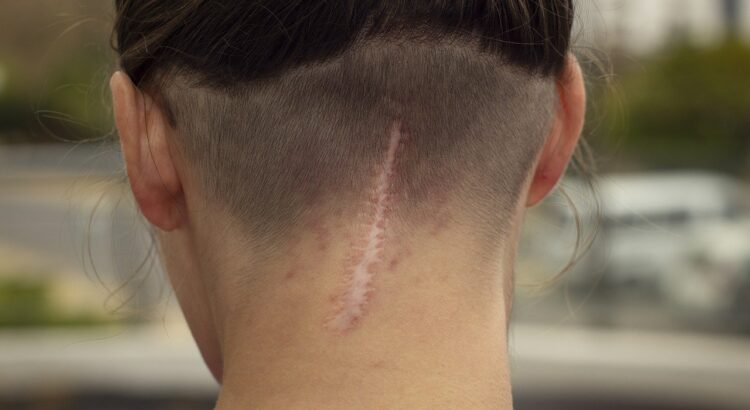The composition and structure of scars vary depending on gender, scientists from the Institute of Animal Reproduction and Food Research of the Polish Academy of Sciences in Olsztyn have shown. Tissues in men are characterised by a higher content of type 1 collagen and elastin. Women, on the other hand, showed a higher accumulation of type 3 collagen, characteristic of scarless wound healing.
– Our work is the first publication to demonstrate differences between men and women over 50 in the structure of cutaneous scars. The obtained results may contribute to the development of research on new pharmaceuticals taking into account gender differences in patients – emphasises Professor Barbara Gawrońska-Kozak, leader of the Regenerative Biology Team at the Institute of Animal Reproduction and Food Research of the Polish Academy of Sciences in Olsztyn.
Her team’s research focuses on understanding the molecular basis of the repair mechanisms controlling the healing process of skin wounds with scar formation (reparative healing), but also in terms of regenerative (scarless), healing.
SCARS ARE NECESSARY
Scars are 'mementos’ left on the skin after various types of injury, such as cuts (e.g. post-operative wounds), lacerations, or burns. The rate of wound healing can be affected by many factors including age, gender, body area, and wound size.
– Scar healing is beneficial for the organism, as it restores, relatively quickly, the protective function of the skin, preventing the penetration of pathogenic microorganisms into the injured area. Unfortunately, disorders in the healing process may result in numerous complications, such as non-healing wounds or hypertrophic scars, explains Prof. Barbara Gawrońska-Kozak.
In the animal world, there is also scarless wound healing, called regenerative or ideal wound healing. – This is the process of regaining the appearance and functionality of uninjured skin. This type of wound healing rarely occurs in mammals. One example of regeneration observed in humans is the healing of skin wounds during the first two trimesters of fetal life. When an injury occurs during this time (e.g. during surgery in the womb), the skin heals scarlessly, with no trace of the injury. Interestingly, research by scientists from the UK has shown that in elderly people, healing of skin injuries lasts longer, but with the formation of a smaller, more delicate scar, with a macroscopic and microscopic appearance resembling uninjured skin – says Dr. Marta Kopcewicz of the Regenerative Biology Team at the IAR&FR PAS.
COLLAGEN TYPE MAKES A DIFFERENCE
To better understand the molecular basis of scar formation and to see what is the role of gender in this process, researchers from Prof. Barbara Gawrońska-Kozak’s team decided to analyse samples of uninjured and scarred skin, collected from men and women over 50. The tissues were taken from the patient’s abdominal areas (with their written consent and under the supervision of the local ethics committee). Doctors from the Voivodal Specialistic Hospital in Olsztyn were involved in the research.
– It has long been known that intact skin varies by gender: in men, among other things, it is thicker, with higher amounts of type 1 collagen, and with more sebaceous glands secreting sebum. Our research indicates that there are also gender-dependent differences in scars – points out Prof. Barbara Gawrońska-Kozak.
Thus: men have more type 1 collagen and elastin in abdominal skin scars than women, which is in line with what is known about differences in uninjured skin. Women, on the other hand, showed higher expression levels of genes specific to the adipose tissue present in the skin.
Interestingly, we observed a higher accumulation of type 3 collagen in women’s scars – a type of collagen that is associated with regenerative wound healing. – These are only the first indications which require further research, but we have presented for the first time that women may have a greater potential for regenerative healing than men – says Dr. Marta Kopcewicz.
The researchers also histologically assessed the structure of scars. Their analyses showed that the arrangement of collagen fibres and their thickness also depended on gender: they are finer in women.
CHANCE FOR NEW MEDICINES
Earlier studies by Dr. Marta Kopcewicz, conducted on animals, showed that age and gender have the greatest impact on the wound healing process. – Our latest research, already conducted on human tissues, has confirmed this – emphasizes the researcher.
According to Prof. Barbara Gawrońska-Kozak, the results may contribute to further research into potential pharmacological products that take gender differences into account. – In addition, our study contributes to important knowledge about scarring in people over 50, when the skin is different from that of young people, who are usually the research group in studies in this area – concludes the scientist.
—
An article presenting the results of the described study was published in the journal Biomedicines and is available here.
